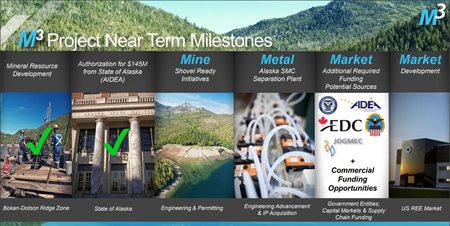Remarkably, the DPA is a war-measures act originally set in place in the 1950’s in response to the Korean War. The act allows the White House, in times of sufficient national crisis, to authorize the American government to take action to make available materials critically required by the US defense sector. Such is now the case, with the DPA Title III Office now having the authority to take steps required to secure US access to select HREE, amongst other critical materials.
For McKenzie and the Ucore team, this fast-tracking has made it the Company’s time to shine. Ucore got to work and promptly responded to the government’s request for information on HREE supplies and projects, with the Alaskan government pitching in to highlight the importance of Bokan-Dotson Ridge.
Already, the Project stands out as a frontrunner. Having five of the government’s most sought-after REE is vital, as well as the fact that the Deposit leans towards the heavier and far rarer REE. In his interview with Stockhouse Editorial, McKenzie highlighted what makes heavy rare earths more valuable.
“It's important to acknowledge that the more strategically important rare metals are the heavy REE. Bokan is a true geological rarity. There are very few REE deposits at a world level that are skewed towards the heavies, making Bokan a member of a very exclusive global club. Within the US, Bokan is even more of a ‘strategic unicorn’. An HREE deposit, located on US soil, containing the very metals that the White House has now earmarked as among the most strategically important to US defense and growth industries, and which can be put into production in the near term. This is a remarkable combination that only Ucore can offer.”
The Plan: Three-Pronged Strategy for Success
What McKenzie’s shareholder update included was a plan for Ucore that matched the current opportunity. On the table for the Company: tens of millions of dollars of potential Federal and State1 government funding and an expedited track to production.
1 With the State component already pre-approved exclusively for the use of Ucore, by way of the $145 M undertaking of the Alaska State Legislature, subject to release by the Alaska Import Development and Export Authority (“AIDEA”).
That has led to Ucore’s current strategy, The M3 Plan of Action . It highlights the Company’s initiatives in a “Mine to Metal to Market” plan that would see the Bokan-Dotson Ridge Deposit shovel-ready in just three years.

(Image via Ucore Rare Metals. Click image to enlarge)
In the “Mine” section of the plan, the Company noted that the Project is ready to commence engineering and permitting required to prep the mine for construction. Next, it is updating the financial projections of the mine, with a substantive amount of co-product elements that weren’t initially assessed within the potential value of the Bokan-Dotson Ridge Deposit.
The “Metal” plan includes the planning and development of an REE processing and separation plant, the Alaska Strategic Metals Complex (SMC). Besides processing the material from the company’s HREE deposit, the SMC offers Ucore’s strategy a big advantage by processing concentrates from other sources, as currently, US-based REE deposits still have to be shipped internationally for processing.
That’s why management outlined the creation of the SMC as a priority (for both the Company and the US) and is planning to complete the REE processing facility before the mine. The plan is for a hybrid technology facility that would start by using the current commercially viable Solvent Extraction platform for mineral processing, before being complemented by developing nanotechnology solutions in the future.
Finally, the “Market” plan focuses on two primary end markets Ucore is targeting. The first is the US government and especially the recent moves by the Department of Defense for the development of HREE-dependent military hardware. Heavy rare earths are required for everything from radar and sonar to fighter jet production, which the Company is able to supply.
The second market is the commercial industry and particularly the automotive sector. Ucore’s plan to operate as the North American HREE solution makes it an attractive supplier of these metals for electric vehicles, smartphone technology, and many electronics that operate with superpowered magnets.
Perhaps the best news for Ucore and its investors is that the US federal government opportunity is, in essence, icing on the cake. The Company already has the strong fundamentals of a resource in demand, financial support, and accessibility to market. Even without the involvement of the White House and the US Department of Defense, the sizable financial contribution of the State of Alaska alone, along with the new fast track plan to production, puts the company on track to become a primary player in the US and international rare earths market.
There’s an additional reason Ucore is developing the SMC processing facility as the first planned physical component of the Bokan Project. Even before the Bokan-Doston Ridge mine goes into production, there is existing demand from international suppliers for REE processing. And as China’s stock of REE reduces, it has already turned into a net importer of REE, which the Bokan-Doston Project will be ready to supply.
Overall, Ucore has assembled a complete package. It has the fundamentals in its strong HREE Bokan-Dotson Ridge Project. It has the opportunity in the increased demand for US-based REE sources and processing. And it has the M3 plan that will bring everything to fruition.
ucore.com
FULL DISCLOSURE: This is a paid article produced by Stockhouse Publishing.